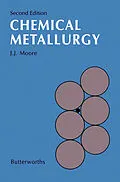Chemical Metallurgy, Second Edition provides the fundamental chemical principles and demonstrates the application of these principles to process metallurgy, materials synthesis and processing, and corrosion protection.
The book consists of nine chapters. The first five chapters emphasize the fundamental chemical principles involved in metallurgical reactions. An additional chapter on slag chemistry has also been added in this second edition in order to provide a more thorough understanding of slag-metal reactions. The final three chapters focus on the applications of the chemical principles to the extraction and refining of metals, metal melting and recycling, and metallic corrosion.
The book will be of value to materials students and teachers and scientists and engineers entering employment in the metallurgical and materials processing and metal finishing industries.
Inhalt
Preface
Units and Symbols
1 Bonding and Periodicity
1.1 The Atomic Structure of Elements
1.1.1 The Nucleus
1.1.2 Atomic Spectra
1.2 The Periodic Table of the Elements
1.3 Chemical Bonds
1.3.1 The Ionic Bond (Electrovalency)
1.3.2 The Covalent Bond
1.3.3 The Metallic Bond
1.4 A More Detailed Study of the Periodic Table of the Elements
1.4.1 The S-Block Elements
1.4.2 Transition Elements (d-Block)
1.4.3 The p-Block Elements
2 Metallurgical Thermodynamics
2.1 Thermochemistry
2.1.1 Exothermic and Endothermic Reactions
2.1.2 Calculating Enthalpies and Enthalpy Changes
2.1.3 Measurement of Enthalpy Changes of Reactions
2.1.4 Enthalpy Changes: The Effect of Temperature
2.2 Thermodynamics
2.2.1 Energy: The Driving Force for Chemical Change
2.2.2 Free Energy: The Driving Force of a Chemical Reaction
2.2.3 Chemical Equilibrium
3 Reaction Kinetics
3.1 Rate of Reaction
3.1.1 Effect of Conditions on Rate of Reaction
3.1.2 Concentration-Time Graphs
3.1.3 Kinetics and Mechanism
3.2 Experimental Rate Laws
3.2.1 Order of Reaction
3.2.2 The Rate Constant
3.2.3 Molecularity
3.2.4 Stoichiometry
3.2.5 Integrated Equations
3.3 Determination of Order of Reaction
3.3.1 Integral Method
3.3.2 Differential Method
3.3.3 Half-Life Method
3.4 Experimental Techniques
3.4.1 General Considerations
3.4.2 Techniques - In General
3.4.3 Techniques - In Detail
3.5 Kinetics and Temperature
3.5.1 The Arrhenius Equation
3.5.2 Determination of Activation Energy
3.5.3 Potential Energy Profiles
3.5.4 Effect of Temperature
3.5.5 Catalysis
3.6 Mechanism
3.6.1 Rate Determining Step
3.6.2 Elucidation of Mechanism
3.7 Theories of Reaction Rates
3.7.1 Collision Theory
3.7.2 Potential Energy Surfaces
3.7.3 Transition State Theory
4 Liquid Metal Solutions
4.1 Solution and Composition
4.2 Surface and Interfacial Energy
4.3 Thermodynamics of Solutions
4.3.1 Partial and Integral Quantities
4.3.2 Ideal Solutions and Activity
4.3.3 Raoult's Law
4.3.4 Non-Ideal or Real Solutions
4.3.5 The Gibbs-Duhem Equation
4.3.6 Henry's Law and Dilute Solutions
4.3.7 Multicomponent Solution and Interaction Coefficients
4.3.8 Thermodynamics of Mixing Solutions
4.3.9 Excess Thermodynamic Quantities
4.3.10 Construction of Equilibrium Phase Diagram from Integral Free Energy-Composition Curves
4.3.11 Free Energy of Nucleation
4.4 Gases in Metals
5 Slag Chemistry
5.1 Functions and Properties of a Slag
5.2 Slag Metal Reactions
5.3 Structure of Liquid Slags
5.3.1 The Cation-O2-Bond
5.3.2 Aluminate and Phosphate Structures
5.4 Liquid Immiscibility
5.4.1 Binary Silicate Melts
5.4.2 Ternary Silicate
5.4.3 Phosphate Melts
5.5 The Transition from Ionic to Covalent Bonding and Polarisation
5.5.1 Thermodynamic Properties-Effect of Non-Ionic Bonding
5.6 Physical Properties of Slags
5.6.1 Electrical and Thermal Conductivities
5.6.2 Viscosity of Slags
5.7 Slag Theories
5.7.1 Ionic Slag Theories
5.7.2 Molecular Theory
5.7.3 Summary of Slag Theories
6 Aqueous Metal Solutions and Electrochemistry
6.1 Ionics I : Ions in Solution
6.1.1 Electrolytes
6.1.2 Aqueous Solutions of Electrolytes
6.1.3 Ionic Activity
6.1.4 Mean Ionic Activity
6.1.5 Debye-Hückel Theory
6.1.6 Measurement of Mean Ionic Activity
6.1.7 Acids and Bases
6.1.8 The pH Scale
6.1.9 Buffer Solutions
6.1.10 Ph Measurement
6.2 Ionics II: Electrolytic Conduction
6.2.1 Measurement of Conductivity
6.2.2 Molar Conductivity
6.2.3 Variation of Molar Conductivity with Concentration
6.2.4 Kohlrausch's Law of Independent Migration
6.2.5 Transport Numbers
6.2.6 Conduction in Fused Salts
6.3 Electrodics I
6.3.1 Electrode Potentials
6.3.2 The Metal Electrode
6.3.3 Comparison of Electrode Potentials-Electrochemical Series
6.3.4 Diagrammatic Representation of Cells
6.3.5 The Standard Electrode Potential
6.3.6 Reference Electrodes
6.3.7 Indicator Electrodes
6.3.8 Cell Mechanism
6.3.9 Concentration Cell
6.3.10 Redox Potentials
6.3.11 Cell Thermodynamics
6.3.12 The Nernst Equation
6.3.13 Calculation of emf (Cell Potential)
6.3.14 Concentration Cell Potentials
6.3.15 Application of the Redox Series
6.3.16 Kinetic Considerations
6.3.17 Variation of Redox Potential with pH
6.4 Electrolysis
6.4.1 Basic Considerations
6.4.2 Faraday's Laws of Electrolysis
6.4.3 Current Efficiency
6.4.4 Energy Efficiency
6.4.5 Current Density
6.4.6 Theoretical Cell Voltage
6.4.7 Polarisation and Overpotential
6.4.8 Decomposition Voltage
6.4.9 Discharge Potential
6.4.10 Electroplating
6.5 Partition (Distribution) - of Solutes Between Immiscible Phases
6.5.1 Extraction
6.6 Ion Exchange
6.7 Adsorption
6.7.1 Gibbs Adsorption Isotherm
6.7.2 Adsorption of Gases
7 Metal Extraction Processes
7.1 Ore Preparation and Mineral Processing
7.1.1 Comminution Processes
7.1.2 Classification Processes
7.1.3 Separation Processes
7.1.4 Agglomeration Processes
7.2 Pyrometallurgical Extraction Processes
7.2.1 Drying and Calcination
7.2.2 Roasting of Metal Concentrates
7.2.3 Smelting
7.2.4 Matte Converting
7.2.5 Reduction of Metal Oxides
7.2.6 Fire Refining
7.2.7 Distillation
7.2.8 Halide Metallurgy
7.2.9 Continuous Extraction Processes
7.2.10 Pyrometallurgical Extraction Procedures for Selected Metals
7.3 Hydrometallurgical Extraction Processes
7.3.1 Leaching
7.3.2 Precipitation Techniques
7.3.3 Isolation Techniques
7.4 Electrometallurgical Extraction Processes
7.4.1 Electrowinning and Electrorefining of Metals from Aqueous Solutions
7.4.2 Electrowinning and Electrorefining of Aluminium and Magnesium and the More Reactive Metals from Fused Salt Electrolytes
8 Metal Melting and Recycling
8.1 Metal Melting
8.1.1 Physical an…
